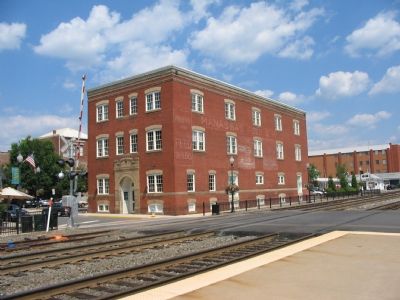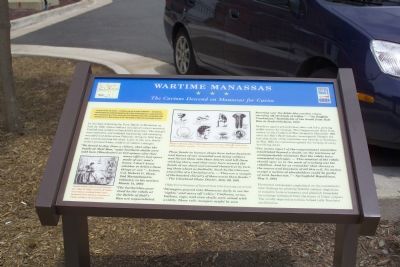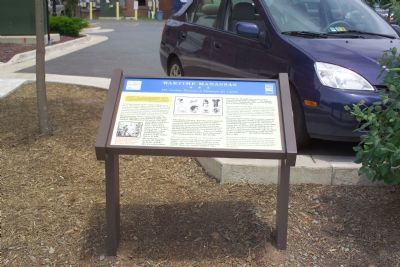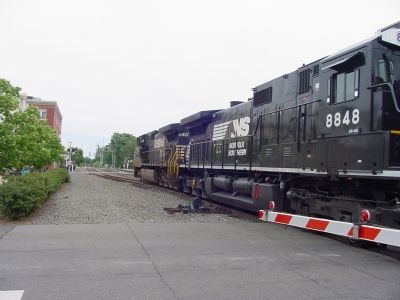Manassas, Virginia — The American South (Mid-Atlantic)
Wartime Manassas
The Curious Descend on Manassas for Curios
In the days following the First Battle of Manassas on July 21, 1861, Union soldiers circulated rumors accusing Confederate soldiers of battlefield atrocities. The charges were extensive and included bayoneting and executing wounded and defenseless Federals, firing on field hospitals, and mutilating the dead. Later in the war, Southerners accused Union soldiers of similar outrages.
“We heard to-day, from a citizen, that after the battle of ‘Bull Run,’ some Northern skulls were sold here [Winchester] at $10 apiece; also that many officers had spurs made of our men’s bones. I don’t know whether to believe these things or not.” —Letter, Col. Robert G. Shaw, 2nd Massachusetts Infantry, to his mother, March 14, 1862
“The barbarities practiced by the rebels at the Battle of Bull’s Run are unparalleled. These fiends in human shape have taken bayonets and knives of our wounded and dying soldiers and thrust them into their hearts and left them sticking there, and that some have severed the heads of our dead and amused themselves by kicking them abut as footballs. Such barbarities are unworthy of a Christian era. — They are a sample of the boasted chivalry of those worse than fiends.” —The Cleveland Plain Dealer, July 29, 1861
Objective witnesses affirmed that relic hunting occurred:
“Strangers poured into Manassas daily to see the ‘sights’ and carry off ‘relics.’ Uniforms, arms, buttons, caps, and even skulls were seized with avidity. These relic mongers might be seen hovering over the fields like carrion crows, carrying off all kinds of trifles.” —“An English Combatant,” Battlefields of the South from Bull Run to Fredericksburg, 1864
Northern papers printed these tales and fed a growing public outcry for revenge. The Congressional Joint Committee on the Conduct of the War, formed in December 1861 after the Ball’s Bluff debacle, investigated. Despite the fact that much of the testimony was hearsay or fictitious, in May 1862 the committee upheld the veracity of every horrifying detail.
“The recent report of the congressional committee established beyond a doubt, on the testimony of unimpeachable witnesses that the rebels have committed outrages. ... This conduct of the rebels should spur us in the work of crushing out the rebellion. And let us remember that slavery is the source and fountain of all this evil. No nation except a nation of slaveholders could be guilty of such barbarism.” —Springfield Republican, May 3, 1862
Illustrated newspapers capitalized on the committee’s false findings by printing fanciful cartoon depictions of macabre bone ornaments and ghoulish household furnishings fashioned from the bones of Union corpses. The vividly depicted atrocities helped rally Northern abolitionists.
Erected by Virginia Civil War Trails.
Topics and series. This historical marker is listed in these topic lists: Communications • War, US Civil. In addition, it is included in the Virginia Civil War Trails, and the Virginia, Wartime Manassas Walking Tour series lists. A significant historical month for this entry is July 1861.
Location. 38° 45.03′ N, 77° 28.31′ W. Marker is in Manassas, Virginia. Marker can be reached from Main Street south of Center Street (Virginia Route 28), on the right when traveling south. It is on the north side of the tracks next to the public parking lot between Main St & Battle St. Touch for map. Marker is at or near this postal address: 9414 Main St, Manassas VA 20110, United States of America. Touch for directions.
Other nearby markers. At least 8 other markers are within walking distance of this marker. Our Story Continues (a few steps from
this marker); Defenses of Manassas (within shouting distance of this marker); Site of Manassas Junction (within shouting distance of this marker); Opera House (within shouting distance of this marker); Manassas 1906 (about 300 feet away, measured in a direct line); Manassas 1905 - The Great Fire (about 300 feet away); Burning of Manassas (about 300 feet away); Jackson's Raid (about 300 feet away). Touch for a list and map of all markers in Manassas.
More about this marker. One in the series of Wartime Manassas Virginia Civil War Trails Marker.
Related markers. Click here for a list of markers that are related to this marker. To better understand the relationship, study each marker in the order shown.
Also see . . .
1. Joint Committee On The Conduct Of The War. Essay on Dick Weeks' website Shotgun's Home of the American Civil War (Submitted on August 19, 2006.)
2. Atrocities, Then and Now. Article by William B. Hesseltine in the Journal of Historical Review. (Submitted on August 19, 2006.)

Photographed By Craig Swain, September 2, 2007
4. The Candy Factory
The marker stands beside a three story brick building which used to be the Hopkins Company Candy Factory. The building dates to 1908 and was later used for milling. The Manassas Feed and Milling Company name is visible in the faded paint. The marker is on the right side of the picture, between the building and the bushes.
Credits. This page was last revised on February 1, 2024. It was originally submitted on August 19, 2006, by Tom Fuchs of Greenbelt, Maryland. This page has been viewed 2,278 times since then and 29 times this year. Last updated on January 26, 2024. Photos: 1, 2. submitted on August 19, 2006, by Tom Fuchs of Greenbelt, Maryland. 3. submitted on August 19, 2006, by J. J. Prats of Powell, Ohio. 4. submitted on September 2, 2007, by Craig Swain of Leesburg, Virginia. • Bernard Fisher was the editor who published this page.


